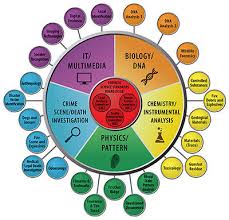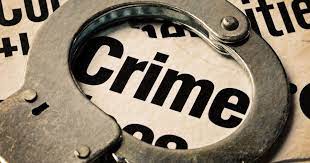Title: Forensic Science in the USA: Unveiling the Intricacies of Criminal Investigation
Introduction

Forensic science plays a pivotal role in the criminal justice system of the United States. It encompasses a range of disciplines, techniques, and technologies aimed at gathering and analyzing evidence to unravel the mysteries surrounding crimes. From fingerprint analysis to DNA profiling, forensic science has significantly evolved, aiding law enforcement agencies in solving complex cases and ensuring justice prevails. This essay delves into the diverse facets of forensic science in the USA, exploring its methodologies, challenges, and contributions to the criminal justice landscape.
Historical Background:
The roots of forensic science in the United States can be traced back to the late 19th century when pioneers like Dr. Edward Heinrich and Dr. Frances Glessner Lee laid the foundation for modern forensic techniques. Throughout the 20th century, advancements in forensic science, spurred by technological innovations and scientific breakthroughs, revolutionized criminal investigations. Landmark cases such as the O.J. Simpson trial highlighted the significance of forensic evidence in courtrooms, prompting greater reliance on scientific methods to establish guilt or innocence.
Key Disciplines and Techniques

Forensic science encompasses various disciplines, each serving a distinct purpose in criminal investigations. These include:
1. DNA Analysis
DNA profiling has emerged as one of the most powerful tools in forensic investigations, enabling the identification of individuals with unprecedented accuracy. The development of DNA databases, such as CODIS (Combined DNA Index System), has facilitated the matching of DNA evidence to suspects and convicted offenders, aiding in the resolution of cold cases and the exoneration of wrongly accused individuals.
2. Fingerprint Analysis
Fingerprint examination remains a cornerstone of forensic identification, relying on the uniqueness and permanence of friction ridge patterns. Automated fingerprint identification systems (AFIS) have streamlined the process of matching latent prints found at crime scenes to known individuals, enhancing the efficiency of forensic investigations.
3. Ballistics and Firearms Examination
Forensic ballistics involves the analysis of firearms, ammunition, and ballistic evidence to link firearms to crime scenes and suspects. Techniques such as bullet trajectory analysis and firearm identification through striation patterns have proven instrumental in linking weapons to specific crimes.
4. Toxicology
Toxicological analysis plays a crucial role in cases involving drug-related offenses, poisoning, and DUI (Driving Under the Influence) incidents. Forensic toxicologists analyze bodily fluids and tissues to detect the presence of drugs, alcohol, and other toxic substances, providing crucial evidence for prosecution.
5. Digital Forensics
With the proliferation of digital devices and cybercrime, digital forensics has become increasingly important in criminal investigations. Digital forensic experts extract and analyze data from computers, smartphones, and other electronic devices to uncover digital evidence, including emails, documents, and deleted files, which can be pivotal in prosecuting cybercrimes and other offenses.
Challenges and Limitations
Despite its invaluable

contributions to the criminal justice system, forensic science faces several challenges and limitations:
1. Backlogs and Resource Constraints
Forensic laboratories often struggle with backlogs due to a lack of resources, including funding, staffing, and outdated equipment. Delays in processing evidence can impede investigations and undermine the timely administration of justice.
2. Subjectivity and Bias
Some forensic techniques, such as fingerprint analysis and bite mark analysis, have been criticized for their subjective nature and susceptibility to human error and bias. Efforts to standardize protocols and enhance training aim to mitigate these concerns and improve the reliability of forensic evidence.
3. Evolving Technology and Legal Frameworks
:The rapid pace of technological advancement presents both opportunities and challenges for forensic science. Keeping pace with emerging technologies requires ongoing training and investment, while legal frameworks must adapt to address novel issues, such as the admissibility of digital evidence obtained from social media platforms and cloud storage.
Contributions to Justice and Public Safety
Despite its challenges, forensic science continues to play a crucial role in ensuring justice and enhancing public safety in the United States. By providing objective, scientifically sound evidence, forensic experts help identify perpetrators, exonerate the innocent, and bring closure to victims and their families. Moreover, advancements in forensic techniques and technologies empower law enforcement agencies to combat crime more effectively, leading to safer communities and a more equitable criminal justice system.
Certainly! Let’s delve deeper into the various aspects of forensic science in the United States:
1. **Education and Training**
Forensic science education and training in the USA vary widely, with programs offered at both undergraduate and graduate levels. Many universities and colleges provide specialized degrees in forensic science, covering areas such as criminalistics, forensic biology, forensic chemistry, and forensic psychology. These programs combine classroom instruction with hands-on laboratory experience to equip students with the necessary skills and knowledge for careers in forensic science.
2. **Accreditation and Quality Assurance**
Accreditation bodies such as the American Society of Crime Laboratory Directors (ASCLD) and the Forensic Science Education Programs Accreditation Commission (FEPAC) set standards for forensic science education and laboratory practices in the USA. Accredited forensic laboratories adhere to rigorous quality assurance protocols to ensure the reliability and validity of forensic analyses and findings.
3. **Interdisciplinary Collaboration**
: Forensic science in the USA relies on interdisciplinary collaboration among various stakeholders, including forensic scientists, law enforcement agencies, prosecutors, defense attorneys, and judges. Effective communication and cooperation among these entities are essential for the successful investigation and prosecution of crimes.
4. **Cold Case Investigations*
: Forensic science has played a significant role in re-examining cold cases—unsolved crimes that have remained dormant for extended periods. Advances in DNA technology, forensic databases, and investigative techniques have led to breakthroughs in cold case investigations, bringing closure to victims’ families and holding perpetrators accountable for their actions.
5. **Crime Scene Investigation (CSI)**
: Crime scene investigation is a fundamental aspect of forensic science, involving the identification, documentation, and collection of physical evidence at crime scenes. Forensic investigators use techniques such as photography, sketching, and evidence collection to preserve and analyze trace evidence, fingerprints, bloodstains, and other clues that may assist in solving crimes.
6. **Forensic Anthropology and Odontology*
: Forensic anthropology and odontology are specialized fields within forensic science that focus on the analysis of human skeletal remains and dental evidence, respectively. Forensic anthropologists assist in identifying human remains, determining the cause and manner of death, and reconstructing events surrounding a person’s demise. Forensic odontologists examine dental records, bite marks, and dental anomalies to establish identifications and provide evidence in criminal investigations.
7. **Quality Control and Ethics**:
Ensuring the integrity and reliability of forensic evidence is paramount in the criminal justice system. Quality control measures, including proficiency testing, validation studies, and blind testing, help maintain the accuracy and objectivity of forensic analyses. Forensic scientists adhere to ethical guidelines and professional standards to uphold the trust and credibility of their findings in legal proceedings.
8. **Emerging Technologies**
: Forensic science continues to evolve with advancements in technology, including next-generation sequencing for DNA analysis, high-resolution imaging for document examination, and artificial intelligence for pattern recognition and data analysis. These technologies enhance the capabilities of forensic laboratories and improve the efficiency and accuracy of forensic analyses.
9. **Legal Challenges and Controversies**
: Forensic science in the USA faces ongoing scrutiny and debate regarding the reliability and validity of certain forensic techniques, such as hair analysis, bite mark analysis, and arson investigation. Legal challenges, expert testimony, and advancements in scientific research influence the admissibility and interpretation of forensic evidence in courtrooms, highlighting the need for transparency, accountability, and scientific rigor in forensic practice.
10. **International Collaboration and Research**
: Collaboration among forensic
 scientists, researchers, and organizations on a global scale fosters the exchange of knowledge, best practices, and research findings in forensic science. International initiatives address cross-border challenges, such as human trafficking, terrorism, and transnational crime, leveraging forensic expertise to support investigations and prosecutions worldwide.
scientists, researchers, and organizations on a global scale fosters the exchange of knowledge, best practices, and research findings in forensic science. International initiatives address cross-border challenges, such as human trafficking, terrorism, and transnational crime, leveraging forensic expertise to support investigations and prosecutions worldwide.
In summary, forensic science in the United States encompasses a diverse array of disciplines, technologies, and practices aimed at investigating and solving crimes, ensuring justice, and enhancing public safety. Through education, accreditation, interdisciplinary collaboration, and technological innovation, forensic scientists contribute to the pursuit of truth and the preservation of the rule of law in society.
Conclusion
Forensic science occupies a central position in the criminal justice landscape of the United States, offering a diverse array of disciplines and techniques to investigate and solve crimes. While challenges such as backlogs and subjectivity persist, ongoing advancements in technology and training hold promise for improving the reliability and efficacy of forensic evidence. As forensic science continues to evolve, its role in ensuring justice and upholding the rule of law remains indispensable, safeguarding the rights of individuals and strengthening the foundations of democracy.


